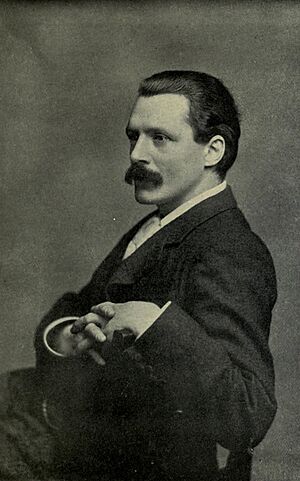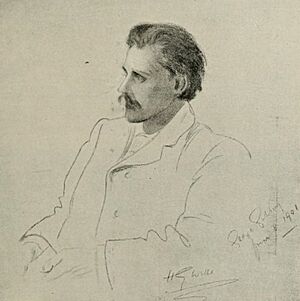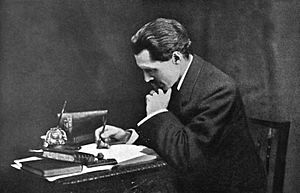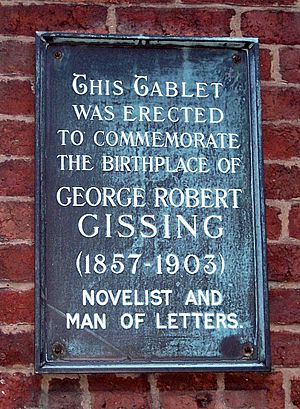George Gissing facts for kids
Quick facts for kids
George Gissing
|
|
|---|---|
 |
|
| Born | George Robert Gissing 22 November 1857 Wakefield, Yorkshire, UK |
| Died | 28 December 1903 (aged 46) Ispoure, Saint-Jean-Pied-de-Port, France |
| Literary movement | Naturalism |
| Notable works | The Nether World (1889) New Grub Street (1891) Born In Exile (1892) The Odd Women (1893) |
| Signature | |
George Robert Gissing (/ˈɡɪsɪŋ/; 22 November 1857 – 28 December 1903) was an English writer. He wrote 23 novels between 1880 and 1903. Some of his most famous books are still read today. These include The Nether World (1889), New Grub Street (1891), and The Odd Women (1893).
Contents
About George Gissing's Life
His Early Years
George Gissing was born on November 22, 1857, in Wakefield, West Yorkshire, England. He was the oldest of five children. His father, Thomas Waller Gissing, owned a chemist's shop. George had four younger siblings: William, Algernon, Margaret, and Ellen. His childhood home in Wakefield is now looked after by The Gissing Trust.
George went to Back Lane School in Wakefield. He was a very hardworking and eager student. His love for books started when he was ten. He read The Old Curiosity Shop by Charles Dickens. His father and the family library encouraged him to read more. He even wrote poems when he was young. These were published later in a book called The Poetry of George Gissing. He was also good at drawing.
When George was 12, his father passed away. He and his brothers then went to Lindow Grove School in Alderley Edge. He was a quiet student there and studied very hard.
In 1872, George did very well in his exams. He won a scholarship to Owens College. This college later became part of the University of Manchester. He continued his studies there and won many awards. These included the Poem Prize in 1873. He also won the Shakespeare scholarship in 1875.
George's time at college ended sadly. He ran out of money and took things from other students. The college found out and he was punished. He was expelled from college in 1876.
In September 1876, George went to the United States. He lived in Boston and Waltham, Massachusetts. He taught classic subjects and wrote. When he ran out of money again, he moved to Chicago. He wrote short stories for newspapers like the Chicago Tribune. He lived in poverty for a while. Later, he worked for a traveling salesman. These experiences helped inspire his 1891 novel, New Grub Street. In September 1877, George left America and returned to England.
His Writing Career

After returning to England, George Gissing lived in London. He worked as a private tutor and wrote stories. His first novel, Workers in the Dawn, was not accepted by publishers. So, he paid to have it published himself. He used money he had inherited.
George spent a lot of time reading old books. He often visited the British Museum Reading Room. He also coached students for exams. He enjoyed long walks through London. On these walks, he observed the lives of poor people. He was very interested in John Forster's Life of Dickens. He wrote in his diary that it was a book he often read for inspiration.
From 1882, George made a good living from teaching. However, he often told his family he was poor. He did this to stop them from asking him for money. He also spent money freely and did not manage his finances well.
George's next novel, Mrs Grundy's Enemies, was bought by a publisher but never released. His novel The Unclassed was published in 1884.
The years after The Unclassed were busy for George. He wrote many novels. Isabel Clarendon and Demos came out in 1886. Demos began his work with Smith, Elder & Co., who published his books until New Grub Street in 1891. His novels from this time often showed a traditional view of working-class people. In 1889, he used money from his book The Nether World to travel to Italy. He was very interested in classic history. His trip to Italy helped him write The Emancipated in 1890.
George had two children, Walter Leonard and Alfred Charles Gissing.
George's books started to earn him more money. New Grub Street (1891) brought him £250. In 1892, he became friends with another writer, George Meredith. George Gissing lived more comfortably in the 1890s. However, his health was not good. This limited the time he spent in London. Novels from this time include Born in Exile (1892), The Odd Women (1893), In the Year of Jubilee (1894), and The Whirlpool (1897). He also wrote short stories. Some were collected in a book called Human Odds and Ends in 1898. Others were published after he passed away. In 1895, he published three shorter novels: Eve's Ransom, The Paying Guest, and Sleeping Fires.
In 1897, George met H. G. Wells, another famous writer. Wells said that George was "a damaged and ailing man."
Later Years and Legacy
After separating from his second wife, George visited Italy again in 1897–1898. He wrote about this trip in a travel book called By the Ionian Sea (1901). While in Italy, he also wrote Charles Dickens: a Critical Study. He met H. G. Wells and his wife in Rome. He also started research for a historical novel called Veranilda. After a short stay in Germany, he returned to England in 1898. He then moved to Dorking in Surrey.
In July 1898, George met Gabrielle Marie Edith Fleury. She was a Frenchwoman who wanted to translate his book New Grub Street. Ten months later, they became partners. They moved to France, where George stayed. He returned to England briefly in 1901 for health reasons. The couple lived in Paris, but moved to Arcachon as George's health got worse. He spent his final years in French villages.
George's relationship with Gabrielle inspired his 1899 novel The Crown of Life. He wrote several novels during this time. These included Our Friend the Charlatan (1901) and Will Warburton (published after his death in 1905). He also worked on his historical novel Veranilda, but it was not finished when he died. In 1903, he published The Private Papers of Henry Ryecroft. This book was about an imaginary writer who inherited money and retired to the countryside. It became very popular.
Besides novels, George also wrote more about Charles Dickens. He wrote introductions for Dickens's books. He also wrote articles for journals and updated a biography of Dickens.
George Gissing passed away at age 46 on December 28, 1903. He caught a cold during a winter walk. He is buried in the English cemetery at Saint-Jean-de-Luz in France. Veranilda was published unfinished in 1904. H. G. Wells visited George in his final days and helped care for him. Wells described George as a "pessimistic writer." He felt George had a brilliant mind but struggled with life's challenges. Will Warburton and his short story collection The House of Cobwebs were published in 1905.
George Gissing is known for his conservative views. He briefly had an interest in socialism when he was young. However, he later lost faith in social movements. He believed in leadership by intelligent people. He did not think that basic education for everyone would lead to a better society.
Writing Style
Many critics believe that Émile Zola influenced George Gissing's writing. However, some, like Jacob Korg, suggest that George Eliot had a greater impact on his style.
Works by George Gissing
- Novels
- Workers in the Dawn, 1880
- The Unclassed, 1884
- Isabel Clarendon, 1885
- Demos, 1886
- Thyrza, 1887
- A Life's Morning, 1888
- The Nether World, 1889
- The Emancipated, 1890
- New Grub Street, 1891
- Denzil Quarrier, 1892
- Born in Exile, 1892
- The Odd Women, 1893
- In the Year of Jubilee, 1894
- Eve's Ransom, 1895
- The Paying Guest, 1895
- Sleeping Fires, 1895
- The Whirlpool, 1897
- The Town Traveller, 1898
- The Crown of Life, 1899
- Our Friend the Charlatan, 1901
- The Private Papers of Henry Ryecroft, 1903
- Veranilda, 1904, unfinished
- Will Warburton, 1905, published after his death
- Travel Books
- By the Ionian Sea, 1901
- Literary Criticism
- Charles Dickens: A Critical Study, 1898
- Short Story Collections
- Human Odds and Ends, 1898
- The House of Cobwebs and other stories, 1906
- The Sins of the Fathers and Other Tales, 1924
- A Victim of Circumstances and Other Stories, 1927
See also
 In Spanish: George Gissing para niños
In Spanish: George Gissing para niños
- Alfred Gissing, his son
- Algernon Gissing, his younger brother





